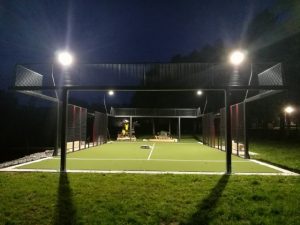
As student interests and facility needs evolve, administrators are increasingly seeking ways to make sports more inclusive, engaging, and space-efficient. Traditional options, such as basketball, soccer, and tennis, still play a valuable role.
Still, many schools are now exploring emerging activities that better align with modern priorities, including student wellness, equity, and resource management.
One sport that’s gaining attention worldwide is padel. Blending some aspects of tennis and squash, padel is a fast-growing racquet sport that’s easy to learn and highly accessible for players of all ages. For schools, it presents an opportunity to expand athletic offerings while utilizing space and budgets more effectively.
Padel’s accessibility is one of its strongest assets. Because the learning curve is gentle, students experience success quickly, which builds confidence and motivation. The doubles format encourages cooperation and communication, making it ideal for fostering teamwork in physical education classes and after-school programs.
Padel’s design makes it naturally inclusive. The court size limits physical strain, the rules are easy to follow, and players of mixed ages and ability levels can participate in games. For schools striving to provide equitable access to physical activity, padel is a great option.
Students who may not participate in high-contact or competitive sports often find padel a more approachable sport. This helps schools reach a broader range of students and reduce barriers to involvement.
Padel’s quick rallies and social format keep students engaged. Because success doesn’t rely on strength or prior experience, participation rates often remain high. Schools that have introduced new, accessible activities, such as pickleball or yoga, have seen measurable increases in student engagement — and padel follows the same trend.
Padel helps to promote cardiovascular fitness, coordination, and balance without the risk of high-impact injuries. The smaller court and slower ball reduce strain on joints while still offering a great workout. For growing students, striking a balance between activity and safety is a crucial consideration.
Unlike traditional sports that may require extensive training or expensive equipment, padel’s simplicity makes it more equitable. A school can introduce the sport without significant additional costs for uniforms or gear. This game promotes inclusivity, ensuring that everyone has an opportunity to participate — not just varsity athletes.
This compact footprint opens possibilities for installation in areas where a full-sized field or court won’t fit, such as near parking lots, playgrounds, or underused corners of athletic complexes.
Schools can repurpose aging or underutilized athletic spaces by replacing one tennis court with two padel courts. For facilities with limited outdoor acreage, this makes it easier to expand programming without acquiring new land.
Because padel courts can be covered or modular, schools in regions with variable weather can support year-round play. An indoor court can also double as a community-use space, increasing the value of the investment.
Building a padel court typically costs less than constructing a new tennis court or adding a gym, mainly due to its smaller footprint and lower material requirements. The surface and enclosure can also be adapted to existing infrastructure, further reducing construction expenses.
Padel courts require minimal upkeep compared to grass fields or multipurpose gyms. The synthetic surface and enclosed design limit wear and tear, meaning fewer resurfacing costs and less downtime for repairs.
Over time, schools save money through lower maintenance costs, reduced water usage, and fewer staff hours required for upkeep.
Padel can be easily integrated into physical education curricula. The basic rules and techniques can be introduced within a single class session, allowing teachers to focus on coordination, teamwork, and movement rather than complex gameplay.
Because it’s a low-impact activity, padel works well as part of a rotation with other lifetime fitness units such as yoga, walking, or pickleball.
Beyond PE, padel fits easily into after-school and intramural programs. Students can organize doubles matches or friendly tournaments with minimal supervision. The small team size makes scheduling easier and reduces the need for large rosters.
This flexibility enables schools to engage students who may not be involved in varsity athletics but still desire structured, social recreation.
Covered or modular padel courts provide year-round use. In colder climates like Pittsburgh, adding a canopy or light structure ensures students can play safely during the winter months. Indoors, courts can even share space with other recreational activities, maximizing value.
Adding padel courts allows schools to expand their athletic offerings without the need for a new gymnasium or field. This supports diverse program options and maintains financial responsibility, a key consideration for both private and public schools.
The addition of padel courts can also enhance marketing materials, open house tours, and promotional campaigns focused on student life and campus facilities.
Padel courts can also be used as shared community spaces. Schools can collaborate with local recreation centers, clubs, or municipal programs to offer evening or weekend access. These partnerships can generate additional revenue or strengthen community relationships.
Padel is a great addition to school athletic programs, promoting inclusivity, wellness, and efficient facility use. With its compact design, low learning curve, and cost-effective maintenance, it’s an ideal choice for schools that want to expand athletic offerings without stretching resources.

Owner & Founded of J Bird's Landscaping & Owner Sport Court of PA. 18+ Years of experience in Pittsburgh Sport court installation, lawn cutting, patio installation, trucking/hauling, French drain installation, and other landscape/design services.


